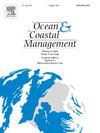Nitrogen budget in a watershed-coastal ocean consortium near the Taiwan Strait: A model study in Han River watershed and its coastal water
IF 5.4
2区 环境科学与生态学
Q1 OCEANOGRAPHY
引用次数: 0
Abstract
In recently decades, many coastal waters have experienced serious eutrophication due to rapid increase in nutrient fluxes in the coastal watersheds. Therefore, understanding the nutrient budget in the watershed-coastal water consortium is essential for effective coastal management. A coupled model consists of watershed model (SWAT) and ocean model with water quality module (ECOMSED + WASP5) was developed to investigate nitrogen budget on seasonal and annual timescales for the Han River Watershed (HRW) -Han River Estuary (HRE) consortium near the Taiwan Strait (TWS). Results showed that wet-season rainfall drove substantial nitrogen loss in the HRW, where nitrate leaching became the dominant nitrogen sink, accounting for approximately 36 % of the total nitrogen loss. Nitrogen retention rate in the HRW was about 80 %, and the other 20 % was transported to the HRE by runoff. The horizontal distributions of dissolved inorganic nitrogen (DIN) and organic nitrogen (ON) in the HRE generally followed the river plume and coastal currents. Nitrogen budgets in the HRE were dominated by physical processes while biogeochemical processes further regulated it. In summer, the nitrogen in the HRE mainly contributed by shelf upwelling, followed by riverine input; in the non-summer season, the nitrogen in the HRE was mainly contributed by the Zhe-Min Coastal Waters. In addition, the riverine DIN input was important in sustaining nitrogen cycling of the HRE. These findings highlight the need for seasonally adaptive management strategies for the HRE and its’ coastal waters, and demonstrates the importance of integrated watershed-coastal ocean modeling for effective eutrophication control in rapidly developing regions.
台湾海峡附近流域-沿海海洋联合体的氮收支:汉江流域及其沿海水域的模型研究
近几十年来,由于沿海流域养分通量的迅速增加,许多沿海水域经历了严重的富营养化。因此,了解流域-海岸水体联合体的营养收支对有效的海岸管理至关重要。以台湾海峡(TWS)附近的汉江流域(HRW) -汉江河口(HRE)为研究对象,建立了一个由流域模型(SWAT)和海洋模型(ECOMSED + WASP5)组成的耦合模型。结果表明:湿季降雨导致了HRW的大量氮损失,其中硝态氮淋溶成为主要的氮汇,约占总氮损失的36%;氮在HRW中的滞留率约为80%,其余20%通过径流输送到HRE。HRE中溶解无机氮(DIN)和有机氮(ON)的水平分布总体上服从于河流羽流和海岸流。HRE氮收支以物理过程为主,生物地球化学过程进一步调控。夏季HRE氮主要由陆架上升流贡献,其次为河流输入;在非夏季,HRE中的氮主要由浙闵沿海水域贡献。此外,河流DIN输入对维持HRE的氮循环也很重要。这些发现强调了对HRE及其沿海水域的季节性适应性管理策略的必要性,并证明了综合流域-沿海海洋模型对快速发展地区有效的富营养化控制的重要性。
本文章由计算机程序翻译,如有差异,请以英文原文为准。
求助全文
约1分钟内获得全文
求助全文
来源期刊

Ocean & Coastal Management
环境科学-海洋学
CiteScore
8.50
自引率
15.20%
发文量
321
审稿时长
60 days
期刊介绍:
Ocean & Coastal Management is the leading international journal dedicated to the study of all aspects of ocean and coastal management from the global to local levels.
We publish rigorously peer-reviewed manuscripts from all disciplines, and inter-/trans-disciplinary and co-designed research, but all submissions must make clear the relevance to management and/or governance issues relevant to the sustainable development and conservation of oceans and coasts.
Comparative studies (from sub-national to trans-national cases, and other management / policy arenas) are encouraged, as are studies that critically assess current management practices and governance approaches. Submissions involving robust analysis, development of theory, and improvement of management practice are especially welcome.
 求助内容:
求助内容: 应助结果提醒方式:
应助结果提醒方式:


